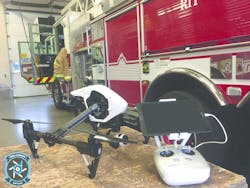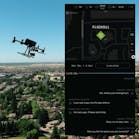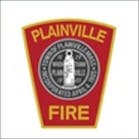The use of drones or unmanned aircraft systems (UAS) has grown like wildfire in the commercial industry; however, like with all things in government, implementation at the fire department level has been a slow process. Paperwork is one of the biggest holdups for departments interested in drone use. With this in mind, I hope to shed some light on the steps needed to obtain your Certificate of Authorization (COA) from the FAA so you can start flying a drone for public safety.
Paperwork, step by step
Drones can offer an amazing perspective for an incident commander needing to make decisions related to the fire or hazmat scene or during search and rescue operations. There are even confined space drones. And with their many advantages, it seems everyone is interested in obtaining a drone for public safety use. The problem: It takes some work.
The first and the biggest hurdle is obtaining a Letter of Declaration. This letter from your state District Attorney’s offices spells out all the rules, laws and regulations that make your city or county entity legal. For example, “The City of XYZ is a home rule municipal corporation and political subdivision organized under Article XYZ of the Constitution of the State of XYZ.” There is other legal jargon that goes into the letter, but this gives you an idea of where to start. You can then email this document along with a brief overview of your operational objectives to the FAA Air Traffic and Law Enforcement Liaison Steve Pansky ([email protected]) and he will grant you access to the UAS COA Online system after a few days.
Once you have been granted access, you can start filling out more online forms for your request. The forms you fill out will require attachments for many sections, so be ready to create a separate Word document or take pictures to attach to the required sections. A few of these sections that will need to be addressed include Operational Description, Airworthiness, Avionics, Lights, Flight Operations Area, and Flight Crew Qualifications. These sections cover the who, what, when, where, why and how of your planned flight operations.
Once you have completed this application, you will submit it and wait … and wait … and wait—up to about 60 days of waiting. During this time, the FAA does a feasibility check, safety review and ATC coordination check of your request. They want to make sure all steps are taken to prevent aircraft mishaps.
In the long run, by obtaining a COA, your department has more leeway with flights and training. The FAA expects you as a public safety entity to meet and/or exceed the training and currency requirements of the commercial industry. You can include night flights with your request so you are not limited to day operations only. You can also conduct in-house training without having to send all your pilots out to take the Part 107 FAA remote pilot test at $150 a test. Instead, your pilots can all fly under one person’s license.
Depending on the amount you want to spend, you can have a drone for about $1,000, but realistically, plan to spend more with batteries, tablets, etc.
One of the drawbacks to obtaining a COA is that you must document everything. In the commercial industry, you should document everything as well, but with a COA, you must send a monthly report documenting your flight ops, and you must maintain updated Certificate of Airworthiness documents for your department, along with insurance.
When your COA is approved, you and your pilots can only fly within the confines of the designated area that is on your COA. To fly outside the confines of your COA, you must have a licensed Part 107 pilot on scene and supervising the operations. These things are easy to achieve, but they just add to the complexity of flying a drone.
In sum
Drone use in the fire service is slowly taking hold and being used to improve safety on many different scenes. The process takes time and effort to get through, with lots of little things that can trip you up. In the long run, the benefits outweigh the cost.
Nathan Rea
Nathan Rea is a professional firefighter and drone pilot. He has more than 16 years in the fire service and military aviation. He is the lead pilot for the Longmont, CO, Fire Department and lead instructor for Squadron Optics LLC, a veteran-owned and operated company. He provides training and consulting for drone use in the public safety sector.





